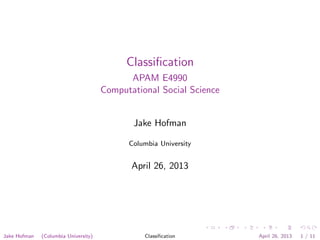
Computational Social Science, Lecture 13: Classification
- 1. Classification APAM E4990 Computational Social Science Jake Hofman Columbia University April 26, 2013 Jake Hofman (Columbia University) Classification April 26, 2013 1 / 11
- 2. Prediction a la Bayes1 • You’re testing for a rare condition: • 1% of the student population is in this class • You have a highly sensitive and specific test: • 99% of students in the class visit compsocialscience.org • 99% of students who aren’t in the class don’t visit this site • Given that a student visits the course site, what is probability the student is in our class? 1 Follows Wiggins, SciAm 2006 Jake Hofman (Columbia University) Classification April 26, 2013 2 / 11
- 3. Prediction a la Bayes Students 10,000 ppl 1% In class 100 ppl 99% Visit 99 ppl 1% Don’t visit 1 per 99% Not in class 9900 ppl 1% Visit 99 ppl 99% Don’t visit 9801 ppl Jake Hofman (Columbia University) Classification April 26, 2013 3 / 11
- 4. Prediction a la Bayes Students 10,000 ppl 1% In class 100 ppl 99% Visit 99 ppl 1% Don’t visit 1 per 99% Not in class 9900 ppl 1% Visit 99 ppl 99% Don’t visit 9801 ppl So given that a student visits the site (198 ppl), there is a 50% chance the student is in our class (99 ppl)! Jake Hofman (Columbia University) Classification April 26, 2013 3 / 11
- 5. Prediction a la Bayes Students 10,000 ppl 1% In class 100 ppl 99% Visit 99 ppl 1% Don’t visit 1 per 99% Not in class 9900 ppl 1% Visit 99 ppl 99% Don’t visit 9801 ppl The small error rate on the large population outside of our class produces many false positives. Jake Hofman (Columbia University) Classification April 26, 2013 3 / 11
- 6. Inverting conditional probabilities Bayes’ Theorem Equate the far right- and left-hand sides of product rule p (y|x) p (x) = p (x, y) = p (x|y) p (y) and divide to get the probability of y given x from the probability of x given y: p (y|x) = p (x|y) p (y) p (x) where p (x) = y∈ΩY p (x|y) p (y) is the normalization constant. Jake Hofman (Columbia University) Classification April 26, 2013 4 / 11
- 7. Predictions a la Bayes Given that a patient tests positive, what is probability the patient is sick? p (class|visit) = 99/100 p (visit|class) 1/100 p (class) p (visit) 99/1002+99/1002=198/1002 = 99 198 = 1 2 where p (visit) = p (visit|class) p (class) + p visit|class p class . Jake Hofman (Columbia University) Classification April 26, 2013 5 / 11
- 8. (Super) Naive Bayes We can use Bayes’ rule to build a one-site student classifier: p (class|site) = p (site|class) p (class) p (site) where we estimate these probabilities with ratios of counts: ˆp(site|class) = # students in class who visit site # students in class ˆp(site|class) = # students not in class who visit site # students not in class ˆp(class) = # students in class # students ˆp(class) = # students not in class # students Jake Hofman (Columbia University) Classification April 26, 2013 6 / 11
- 9. Naive Bayes Represent each student by a binary vector x where xj = 1 if the student has visited the j-th site (xj = 0 otherwise). Modeling each site as an independent Bernoulli random variable, the probability of visiting a set of sites x given class membership c = 0, 1: p (x|c) = j θ xj jc (1 − θjc)1−xj where θjc denotes the probability that the j-th site is visited by a student with class membership c. Jake Hofman (Columbia University) Classification April 26, 2013 7 / 11
- 10. Naive Bayes Using this likelihood in Bayes’ rule and taking a logarithm, we have: log p (c|x) = log p (x|c) p (c) p (x) = j xj log θjc 1 − θjc + j log(1 − θjc) + log θc p (x) Jake Hofman (Columbia University) Classification April 26, 2013 8 / 11
- 11. Naive Bayes We can eliminate p (x) by calculating the log-odds: log p (1|x) p (0|x) = j xj log θj1(1 − θj0) θj0(1 − θj1) wj + j log 1 − θj1 1 − θj0 + log θ1 θ0 w0 which gives a linear classifier of the form w · x + w0 Jake Hofman (Columbia University) Classification April 26, 2013 9 / 11
- 12. Naive Bayes We train by counting students and sites to estimate θjc and θc: ˆθjc = njc nc ˆθc = nc n and use these to calculate the weights ˆwj and bias ˆw0: ˆwj = log ˆθj1(1 − ˆθj0) ˆθj0(1 − ˆθj1) ˆw0 = j log 1 − ˆθj1 1 − ˆθj0 + log ˆθ1 ˆθ0 . We we predict by simply adding the weights of the sites that a student has visited to the bias term. Jake Hofman (Columbia University) Classification April 26, 2013 10 / 11
- 13. Naive Bayes In practice, this works better than one might expect given its simplicity2 2 http://www.jstor.org/pss/1403452 Jake Hofman (Columbia University) Classification April 26, 2013 11 / 11
- 14. Naive Bayes Training is computationally cheap and scalable, and the model is easy to update given new observations2 2 http://www.springerlink.com/content/wu3g458834583125/ Jake Hofman (Columbia University) Classification April 26, 2013 11 / 11
- 15. Naive Bayes Performance varies with document representations and corresponding likelihood models2 2 http://ceas.cc/2006/15.pdf Jake Hofman (Columbia University) Classification April 26, 2013 11 / 11
- 16. Naive Bayes It’s often important to smooth parameter estimates (e.g., by adding pseudocounts) to avoid overfitting Jake Hofman (Columbia University) Classification April 26, 2013 11 / 11